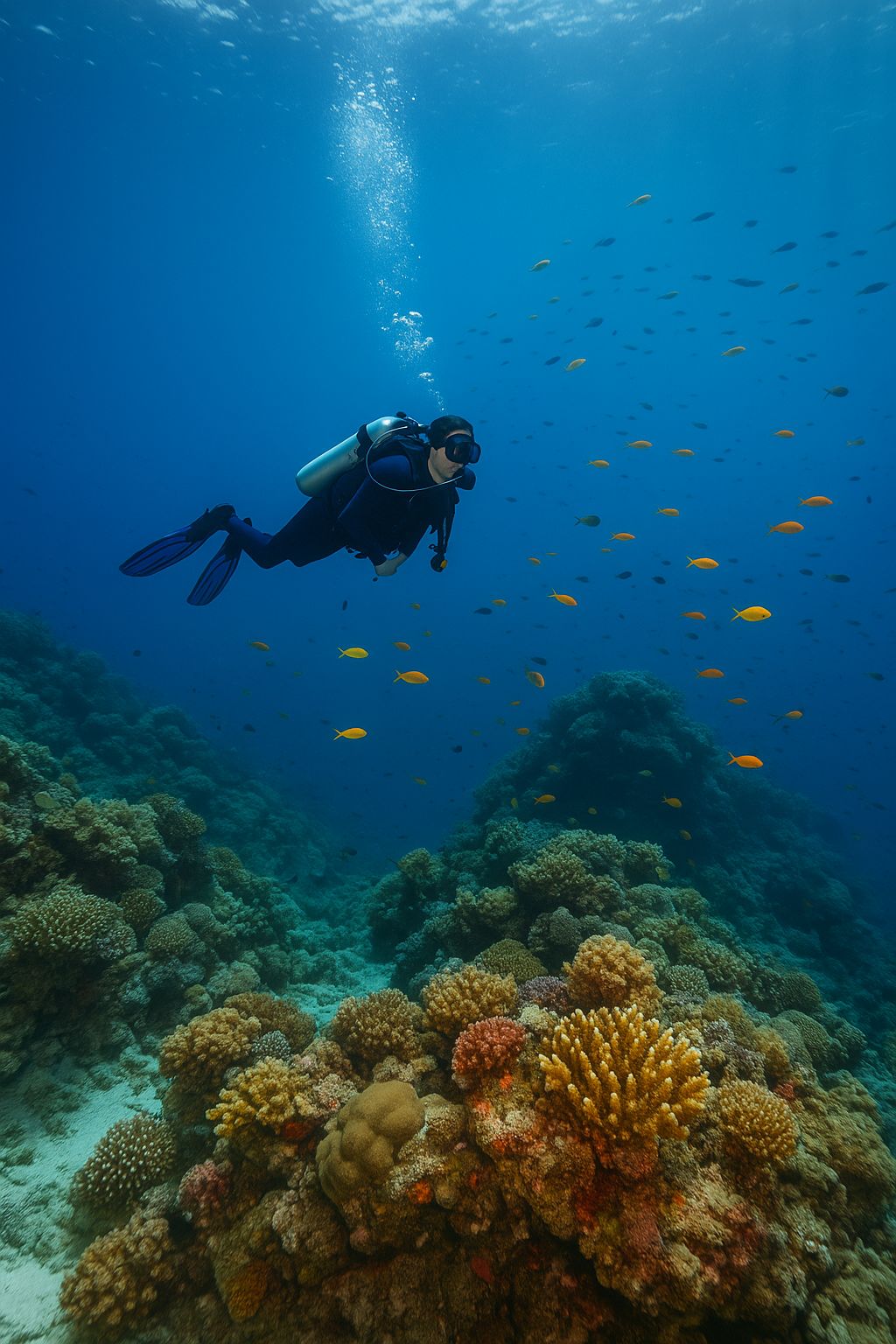🌊 What Is Drift Diving?
Picture yourself floating weightlessly, with the ocean’s current carrying you effortlessly along a coral wall. You’re not finning hard or swimming against the tide — you’re simply gliding, like a passenger on an underwater conveyor belt. Schools of fish move around you in perfect formation, large pelagics appear suddenly in the blue, and every minute brings something new into view.
That’s the magic of drift diving. Unlike typical dives where you return to the boat or entry point, a drift dive lets the current be your engine. Your dive boat follows along and picks you up when you surface. It’s relaxed, exhilarating, and a style of diving that both beginners and seasoned explorers can enjoy.
🧭 Why Drift Diving Is Worth Trying
Effortless Exploration: You save energy by letting the water carry you, extending your bottom time.
Cover More Ground: See more reef, walls, or channels in one dive than you ever could finning.
Big Animal Encounters: Currents bring nutrient-rich plankton, which attract manta rays, sharks, and large schools of fish.
Peaceful & Relaxing: Once you find your buoyancy, the feeling of being carried by the ocean is meditative — like flying.
For many divers, their first drift dive becomes one of their most memorable experiences underwater.
Join over 4 million Americans who start their day with 1440 – your daily digest for unbiased, fact-centric news. From politics to sports, we cover it all by analyzing over 100 sources. Our concise, 5-minute read lands in your inbox each morning at no cost. Experience news without the noise; let 1440 help you make up your own mind. Sign up now and invite your friends and family to be part of the informed.
🐠 Essential Beginner Tips for Drift Diving
1. Master Your Buoyancy First
Drift diving isn’t the place to learn buoyancy control. If you’re still yo-yoing up and down, take a refresher course first. Staying neutrally buoyant lets you ride currents smoothly without bumping into reefs or exhausting yourself.
2. Pay Close Attention to the Dive Briefing
Every drift dive is different. Your dive guide will explain entry and exit procedures, signals, and current direction. Unlike a calm reef dive, details matter — from where to descend to how to regroup if separated.
3. Stick Together
The current can spread divers out quickly. Stay close to your buddy and follow your guide. If you lose sight of the group, don’t panic — follow your training: look around for 1 minute, then surface slowly while releasing your SMB (Surface Marker Buoy).
4. Keep a Low Profile
To avoid being swept too high or dropped too low in the water column, maintain a streamlined horizontal position. This helps you move smoothly with the current and conserves energy.
5. Carry the Right Gear
A few tools make drift diving safer and easier:
SMB/DSMB: To signal your position at the surface.
Whistle or Dive Alert: Audible surface signaling device.
Reef Hook: Useful in strong currents if you want to stay in one place to watch marine life.
Dive Computer: To track depth, ascent rate, and safety stops.
🌍 Where to Try Drift Diving
Some destinations are world-famous for drift dives — and perfect for building experience:
Cozumel, Mexico → Known as the drift diving capital of the Caribbean, with consistent currents along stunning walls. Great for beginners.
Maldives → Channel dives where manta rays and sharks soar past you, carried by rushing currents.
Palau, Micronesia → Legendary drift dives like Ulong Channel, where you fly past coral gardens and end in a sandy lagoon.
Raja Ampat, Indonesia → Nutrient-rich currents fuel some of the most biodiverse reefs in the world.
Bonaire → Generally calm, but offers some gentle drifts for divers easing into the style.
✅ Safety Reminders
Drift diving is safe when done properly, but it does come with unique considerations:
Always dive within your certification limits and comfort zone.
Descend and ascend as a group when possible.
Never fight the current — if it feels strong, tuck in and let it move you until you find calmer water.
Keep your hands off the reef. It’s tempting to grab something for stability, but touching coral can damage delicate ecosystems and injure you.
Do a safety stop — even if drifting — by inflating your SMB and ascending slowly with your buddy.
🌟 Drift Diving Myths — Busted
“It’s only for advanced divers.”
Not true! Many drift dives are beginner-friendly, especially in places like Cozumel where currents are steady but predictable. With good buoyancy, even Open Water divers can enjoy them.“You’ll get swept out to sea.”
If you follow your briefing, use an SMB, and stick with your group, boats are trained to track bubbles and pick up divers along the drift line.“You can’t see much because you’re moving too fast.”
Actually, drift diving lets you see more reef in less time. The current often carries you past coral heads, drop-offs, and open blue where big animals appear.
🐟 What You Might See on a Drift Dive
Because currents carry nutrients, drift dives often deliver incredible marine life encounters. Imagine:
A manta ray soaring like a giant kite just meters away.
Reef sharks effortlessly gliding against the current.
Schools of jackfish or barracuda swirling in silver tornadoes.
Tiny critters like nudibranchs and pygmy seahorses tucked into corals — spotted if you slow down near calmer patches.
Every drift dive is different, which makes each one feel like a mini-adventure.
📝 Pro Tips From Seasoned Drift Divers
Enter the water quickly after the signal so the group doesn’t scatter.
Streamline your gear — dangling gauges or straps increase drag.
Stay calm if the current picks up; tucking in close to the reef or behind coral bommies can give you shelter.
Practice SMB deployment before your trip — it’s harder in currents if you’ve never done it.
✨ Final Thought
Drift diving is the closest you’ll ever come to flying underwater. It’s exhilarating, calming, and opens the door to spectacular marine life encounters. With a little preparation, even beginners can enjoy it safely and confidently.
So, if you’ve mastered your buoyancy and are ready for the next step in your scuba journey, add a drift dive to your bucket list. Once you experience the ocean carrying you along, you may never look at diving the same way again.
💡 Have you drift dived before? Reply and share your story — your experience could inspire fellow Salty Reef readers in our next issue!




